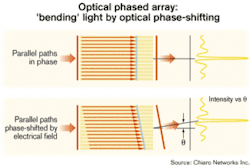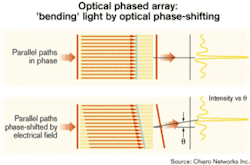Novel optical-switch design underlies new router
In operation, light enters the switching fabric via a polarization-maintaining singlemode fiber (see Figure). A combination of air gaps and coupling optics spreads the light beam across a gallium arsenide (GaAs) device Chiaro calls a deflector that contains 128 optical waveguides. The guides comprise two layers of aluminum GaAs (AlGaAs) that sandwich GaAs doped to create a P/N junction. Left alone, the light would travel through the 128 waveguides in phase, creating a diffraction pattern on the opposite side whose maximum intensity would be directly in front of the deflector. But when voltages of 0-2.5 V are applied to the individual waveguides within the deflector, the refractive index of the waveguides changes, thus creating phase-shifts among the light beams traveling down the waveguides. The relative phase-shifts between the light beams as they exit the deflector results in a geometric shift in the point of greatest intensity—in effect, switching the light beam from directly ahead to a different position.
According to Dr. Eyal Shekel, founder, vice president, and general manager of Chiaro, the deflectors can shift the point of greatest intensity between 0 and 2π. Enstara currently supports switching speeds of 30 nsec; however, Shekel says the technology can switch even faster with the application of more powerful drive electronics.
Of course, once the light enters the system, it must leave. The Enstara switch architecture uses a collimating lens, mirror, and coupling optics to direct the switched beam to the target 62.5-µm multimode output fiber. The mirrors are necessary because the fabric comprises four units, each of which contain 18 deflectors (only 16 of which are currently used) in a GaAs package 1.2 inches wide by 0.5 inch high to create a 64×64 matrix. The output fibers are bundled in a single place, and the mirrors direct the outputs of the four units to the output bundle.
The entire switch offers a worst-case loss of about 13 dB, reports Shekel; typical loss is 10 or 11 dB, he says. Accumulated crosstalk with all the waveguides active is between -20 and -25 dB.
Chiaro has already begun development of the next generation of this architecture. The new version, which Shekel says has already been demonstrated, will use standard singlemode fiber for input and output. The drive electronics also have been improved to support faster switching speeds, with the hope of accommodating burst-packet traffic. Shekel expects platforms with this enhanced version of the switching fabric to reach general availability in a couple of years.
Meanwhile, the current version of Enstara already has made its mark. The company announced a contract with the University of California/San Diego late last year and followed with the announcement of a contract from IP Networks Inc. (San Francisco) in May. According to Chiaro president and CEO Ken Lewis, the briefcase-sized switching fabric will enable future versions of the Enstara to provide 6 Tbits of switching in a 7-ft rack. (The current system supports 400 Gbits/sec via 10-Gbit/sec card slots.) The router obviates the need for router clusters to deliver similar capacity, thus saving as much as 60% in capital expenditures, Lewis says. The system also is designed to ensure "carrier class" operation, including minimization of downtime due to network faults, via a combination of hitless fail-over and a technique the company calls "stateful assured routing." The latter provides stateful protocol protection to BGP, ISIS, OSPF, multicast, and MPLS.

